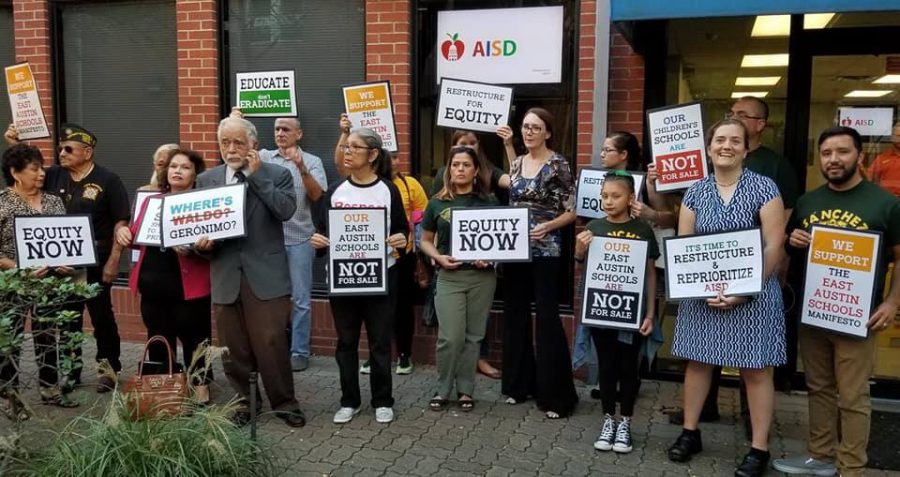Reedy Spigner describes how he first became involved in Austin ISD the day his daughter Emily started kindergarten. He found himself “discontented” with the “crisis facing East Austin schools.” This year, as Emily started fifth grade, he joined the East Austin Schools Coalition, a group of concerned parents, government officials and community leaders led by trustee Ted Gordon. On September 5th they gathered at Sims Elementary, which the district is considering closing due to low enrollment.
“The goal of any school board should be the academic achievement of the community’s children, not capitalizing from the sale and transfer of school resources and assets,” he declared to the gathered crowd, which included Former trustee Paul Saldana, city council candidate Lewis Conway Jr., former school board president Kendall Pace and representatives from organizations like NAACP, LULAC and Education Austin.. “Austin ISD has failed the families of east Austin. The growth that Austin is experiencing should enhance each community, not continue the historic inequality that currently exists. Strong neighborhoods need great schools. They are the foundation of community.”
The group then released a 15-point list of their demands, which they are calling the East Austin Schools Manifesto. They say that they plan to organize walkouts, boycotts and lawsuits if the district does not work with them. If all else fails, the group says they will split away from Austin ISD to form their own district. They also plan on running candidates for political office that support their cause.
The East Austin Schools Coalition has provided a summary of their plan, boiled down to three specific objectives: that AISD should “do all in its power to improve the academic achievement of its minority students,” which they say it is currently not doing; better compensate and provide more benefits for teachers, particularly those in Title I schools in order to promote teacher achievement and retention; and finally, combat segregation by redrawing boundaries or allowing East Austin to form its on district.
In response, Austin ISD released a statement, saying “Our values at AISD include equity, diversity and inclusion … We acknowledge there is still work to do when it comes to equity and we encourage constructive engagement around this issue – All means all.”
Spigner says that the ideas that they are promoting are not new ones, but they are trying to solve them with renewed vigor.
“This manifesto and coalition are the culmination of years of displeasure with the inequity that exists in AISD and disappointment with the lack of meaningful action,” he said. “After making our concerns heard through school board meetings, publishing newspaper opinion pieces and organizing protests prior to and during the $25 million merger between Norman-Sims; a group of concerned citizens realized a plan of action and solutions were needed. Thus, the East Austin Schools Manifesto.”
Their specific demands include ending the open-transfer policy, which allows for students to choose which school they attend, more intensive deliberation for school closures, greater affordable-housing options, higher salaries for teachers and staff, and a more decentralized central administration.
The coalition that released the manifesto is an offshoot of the East Austin Coalition for Quality Education, a group formed around four years ago in the wake of Gordon’s election by a group of parents, teachers and community members.
“Most of the issues in the manifesto have been discussed for years and are issues the community, including myself, has been concerned about for many, many years,” Rox Evans, a long-term member of the coalition, said. “When Dr. Gordon agreed to run for a second term, the East Austin Coalition expanded, to include more voices, and took many of the community issues and created the manifesto.”
The East Austin group met with Superintendent Paul Cruz on Sept 18 and has met with him once previously. Attorney and Texas Civil Rights Project founder Jim Harrington, an original member of the Manifesto Coalition, says that district response has been weak, and they have given them until Oct. 18 to produce an official written response to each of the 15 items in the manifesto. If their concerns are not sufficiently addressed, he adds, they will undertake legal action. Specifically, they will pursue a lawsuit and/or a Title VI complaint in addition to other direct actions.
Representatives refer to an achievement gap in the district; in 2018, 76 percent of white students met standards on the STAAR exams, while only 32 percent of African-American students and 40 percent of Hispanic students met the same standards. Additionally, one in three black children and one in four Latino children in Austin live in poverty; meanwhile, five percent of white children and four percent of Asian children do. 61 percent of black and 52 percent of Latino children attend schools with high teacher turnover rates.
The other trustees have said in interviews that they acknowledge the issues Gordon addressed, but wished he would have done so in a less public manner. Gordon has responded by saying that he has already raised those concerns in the past but felt that the response from the district was ineffective and minimal.
“When I originally ran for trustee in my first term, I told the people who were asking me to run that I would not run unless there was a organized group of people who were interested in similar ideas that I had and who would work to support those ideas and to support me as I tried to change the school district from a position of trustee,” he said. “So I started out the organization and working from the outside of the district before I started working from the inside of the district. The other thing is that this strength of ideas and support for ideas that one has in terms of working in any particular organization, including the Board of Trustees, comes from the kind of support from one’s constituents. And so therefore the power of your message and the power of your ability to move things politically has everything to do with whether or not the people are behind it.”
Previous programs implemented to address inequality in the district include full-day Pre-K, early college high schools and Career Launch.
As for the plan to split the district, they say that it could “reduce AISD’s financial responsibility through the state’s ‘recapture’ plan,” a state policy that sends tax money from property-wealthy districts like Austin to poorer districts. They are also considering merging East Austin with a nearby district like Del Valle. They say it would be better for recapture money for Austin ISD to stay in Austin rather than be sent to another part of Texas. Chapter 41 of the Texas Education Code allows such a separation if the trustees vote to do so to reduce property tax wealth.
The group further criticized the district’s actions in an op-ed in the Austin American-Statesman, saying that the $4 million the district spent on a public relations campaign last year should have been used to improve East Austin schools. In the op-ed, they called the potential new district “Capitol ISD,” and described its boundaries as “along Austin ISD’s historical lines of discrimination: east of I-35 to the Texas 130 toll road; north to Walnut Creek; and south to Texas 45. It would encompass the property along both sides of I-35 and include North Austin to Lamar Boulevard.”
Imagining the operations of this Capitol ISD, they said, “Instead of Austin ISD transferring the expanding wealth from new housing developments and businesses in East Austin to west of I-35, Capitol ISD would have access to that wealth. It would have funds to refurbish buildings, reward dedicated teachers, unleash education creativity, create community school hubs from 7 a.m.-8 p.m., and disperse administrative staff throughout local schools, so every day they would see the kids they serve. There would be no behemoth administrative temple like Austin ISD’s.
Evans says that the group has been encouraged by the response they’ve gotten so far from the community.
“The manifesto has gained support from parents and teachers and others of various ethnicities, income levels, and neighborhoods across Austin,” she said. “This confirms that people throughout Austin are concerned about equity and quality education for all students.”
Evans says she believes that if the district adopts the solutions in the manifesto, they will gain more students, improve student performance and stop losing students to charter schools. She adds that based on that, they won’t have to close any schools due to under-enrollment.
Harrington adds that he originally joined the group because of the divide he saw first-hand between different schools.
“I joined because AISD continues to neglect East Austin schools,” he said. “I have been involved more than a year, trying to improve the quality of education of Norman/Sims and Pecan Springs schools… The quality of schools and education on the East side is markedly different from the schools on the West side.”
Gordon says that though much of the problem is caused by historical inequality, the district should be doing more to address it.
“The issues that are on there have been issues that we’ve been talking about for more than 30 years and really have been issues that people in East Austin been talking about since school integration 40 years ago… it’s always important to talk about these things, but it seems like these things have become an emergency,” he said. “The kinds of things we’re talking about in terms of school achievement and faculty pay are an emergency, as much as the gaps in terms of academic achievement are as high as they’ve ever been between children of color and other children, and also the problems in terms of reasonable pay for teachers… And so these things are an emergency, but they’re particularly an emergency in a situation where the district has also got a $30 million deficit that it has to fill… And we feel like there… if there are scarce resources we need to figure out what those priorities for spending those resources are going to be. And we’re saying that those resources should be spent on the things that just historically been neglected, and things that have been historically neglected most especially is the education of poor kids and kids of color.”
Spigner further criticizes the district for considering closing schools in East Austin.
“This problem is multiplied by gentrification, which has resulted in a population decline among families with children in East Austin,” he said. “As a result, discussion shifts to closing schools and land transfers. The goal of any school board should be the viability and academic achievement of the community’s children, not capitalizing from the sale and transfer of school resources and assets… Scarcity of land will continue to make real estate more expensive. The ability to replace existing schools, closed or sold within the district, at a later date will be impossible. I wonder will there come a time when no schools exist in East Austin?”
Gordon says that if people want to support their work, they can come to the meetings held the third Wednesday of every month, writes their trustees and come to board meetings to make their opinions heard.
Conway Jr. says that as an East Austinite, he felt that he needed to stand with the group, and encourages others to do the same.
“I think any document that calls for change and upsetting the status quo is revolutionary”, he said. “We need revolutionary thinking to reverse the present trend in education on the East side.”









Maeve W • Oct 22, 2018 at 2:33 pm
I really enjoyed this article. It had so much important information and facts about East Austins district. I like the photo added at the top I think it added more emotion to the piece and I really appreciated the amount of quotes added because it helped convey the story from East Austin side. It taught me a lot of new information on a subject I was not even aware of before.